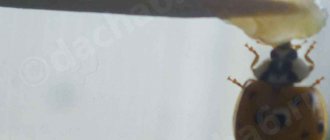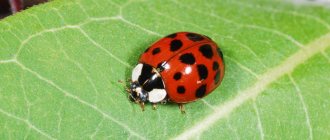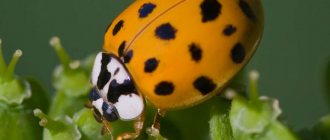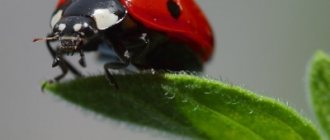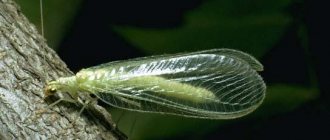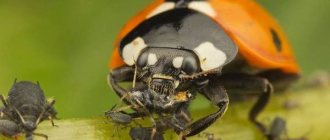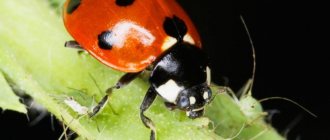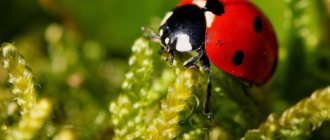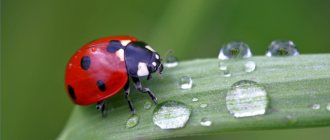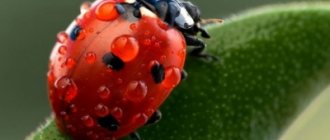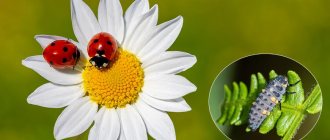- Ladybug: description, structure, characteristics. What does a ladybug look like?
Ladybug, fly to heaven, bring us bread, black and white, but not burnt. (Children's song).
Among all the insects that live in our latitudes, it is the ladybug that enjoys the greatest respect and honor. After all, even the name itself - “ladybug” speaks of a certain divinity of this creature. Why is the ladybug a ladybug? What habits does this insect have, what types of ladybugs are there, where they live, what they eat and many other interesting things about them, read on.
Where does the name ladybug come from?
The ladybug received its unusual name due to its bright red color, which aroused the sympathy of people. So, for example, in Slovenia and the Czech Republic it was called the “sun” (Slunechko), in Germany and Switzerland it is known as the “Virgin Mary’s bug”, in Latin America it is called “St. Anthony’s cow”. What is the origin of the name “ladybug”, there are two versions in this regard, according to the first, it was called “ladybug” for its ability to secrete poisonous milk, which scares off potential predators; our ladybug received the prefix “ladybug” for its meek and peaceful disposition. According to another version, these insects became “God’s” due to their ability to destroy aphids, thereby helping to preserve the crop.
Why don't birds eat ladybugs?
They are inedible for most birds and animals. These beetles have a method of defense that makes birds dislike them. As protection, they use provocative bright colors; they are able to imitate reflex bleeding, resulting in the release of bitter, strong-smelling discharges, including poisonous ones. Their blood acts as a repellent and contains pyrazine and other alkaloids.
Red color serves as a warning signal. If a bird eats a ladybug, it will associate the color red with bad taste and will never touch it again.
Description, structure, characteristics
According to the biological classification, the ladybug is an arthropod insect that belongs to the Coleoptera and the family of ladybirds.
The size of a ladybug ranges from 4 to 10 mm. The shape of their body is either round or oval-elongated, flat below and very convex above. The body surface of some types of ladybugs is covered with fine hairs. The structure of their body includes a head, a pronotum, a chest consisting of three sections, an abdomen, wings with elytra and three pairs of paws.
The ladybug's head is small (although in some species it may be slightly elongated), it is motionlessly connected to the anterior chest. But the ladybug's eyes are relatively large. The insect's antennae, which consist of 8-11 segments, are highly flexible.
The ladybug's pronotum is convex, has a transverse structure and a notch at the anterior edge. On its surface there are often “signature” spots of different shapes.
Thanks to the presence of three pairs of paws, the ladybug can move quite quickly both on the grass and along plant stems. The abdomen of ladybugs consists of five or six segments, which are covered from below by sternites (segmental semirings).
Despite the fact that ladybugs have two pairs of wings, they fly only with the help of their two hind ones. The front wings, in the process of evolution, were transformed into hard elytra, which serve as protection for the hind wings at the moment when the ladybug is on the ground.
As a means of protection against predators, ladybugs are capable of secreting a kind of poisoned “milk” - cantharidin, a toxic yellow liquid that also has an unpleasant odor. Additionally, the bright colors of the ladybug scare away enemies. The color of the ladybug's protective covers can be not only bright red, but also yellow, black, white with spots of different colors and different configurations. Sometimes the pattern on the pronotum of a cow can indicate its gender.
Lifestyle and habitat
Of course, such creatures can fly; this is even stated in children’s rhymes. And they have two whole pairs of wings. True, only the rear ones are adapted for air movement, and the front ones, in the course of evolution, turned into rigid protective wing covers.
insect from the encroachments of ill-wishers . The ladybug is so bright that it can scare away predators. But it’s not just the overly conspicuous coloring that plays a role here.
A good defense against potential attackers is the special natural liquid secreted by such insects in anticipation of danger. This is what is commonly called cow's milk.
In case of danger, the ladybug secretes a specific liquid
It has an unpleasant odor, is poisonous, has a yellow tint, and contains cantharidin. This milk repels all insidious predators, even the formidable tarantulas. And almost no one in nature dares to touch the harmless ladybug.
However, there is still a parasitic insect from which such creatures have no protection. These are dinocampuses. They gradually kill the cows and their pupae by placing their eggs there, which destroy them as they develop.
The habitat of ladybugs depends on their variety. Some of them are perfectly adapted to live in meadows near rivers and streams; others can only exist in trees. There are known varieties that settle only on certain types of flora, for example, aquatic plants, reeds, sedges, field grasses; some look for places where aphids accumulate because they feed on them.
However, ladybugs of any species are not social and prefer for the most part an existence isolated from their relatives. But at certain times they break this rule. For example, during the breeding season or when they gather together for winter flights to areas of the planet where there is no cold.
In general, different types of ladybugs spend the cold season in their own way. Those of them that have adapted to life in temperate areas and are sedentary usually choose convenient shelters from winds and frosts: terraces, garages, barns, houses.
Sometimes, in search of shelter, they unite in groups, even large communities, the number of individuals in which amounts to tens of millions. In winter, they can hide in piles of leaves, bark and rocky debris.
Habitats
Ladybugs live over a wide geographical range, on almost all earthly surfaces.
continents with the exception of Antarctica and the polar Arctic regions. As for habitats, some of them prefer to live on plants where a colony of aphids has formed, others choose sedge and reeds along water bodies as a home, while others live in field grasses.
Population and species status
Photo: Ladybug
The population of ladybugs has decreased significantly due to active control of aphids. These little bugs simply have nothing to eat. Due to rapid reproduction and a small number of natural enemies, the population is able to recover in a short period of time if food is available. The status of the species is currently stable. At this time, only some rare varieties of these beetles are under threat of complete extinction, for example, the Australian blue and pointless ones.
Interesting fact: In search of food, a hungry ladybird larva can travel up to 12 meters, which is a huge distance for insects.
Trying to restore the population of beneficial bugs artificially, people sometimes, even with their good intentions, on the contrary, cause significant damage to it. In recent years, millions of individuals, specially bred ladybugs, have been released into their natural habitat, which, due to obvious mutations, changed the nature of their feeding and chose their own relatives as victims. All this caused the death of a huge number of beneficial bugs in all European countries. A thoughtful approach to this problem is needed without undue interference in the natural course of processes in nature.
Nutrition
All ladybugs are predators, but the predators are very useful for humans, since they eat various harmful parasites: aphids,
ticks, small caterpillars. Sometimes during hunger they will not disdain even the eggs of the Colorado potato beetle. Some types of ladybugs also eat plant foods: mushroom mycelium, plant pollen, leaves and flowers of some trees.
Sex life of ladybugs (2 photos)
Scientists have found that nine out of ten ladybugs suffer from a fungal venereal disease. Bright two-spotted ladybugs that live in cities where the air is full of industrial fumes are gradually darkening. And darkened ladybugs warm up better under the meager rays of the sun penetrating through air polluted by industrial waste, so they find food faster than bright bugs and reproduce better. As a result, ladybugs began to multiply at an incredible rate. So fast that their generations can now produce offspring from each other. And this increased the risk of spreading sexually transmitted diseases. Fortunately for ladybugs, the effects of the disease are much milder than in humans. This disease occurs in a very mild form. In Eastern Europe, ladybugs suffer from more serious diseases that lead to infertility. Then from the day of infection they have only 17 days to reproduce. Details of the sex life of ladybugs. Meeting of the sexes, courtship and mating.
If males and females are isolated for several days and then put together in a transparent Petri dish, mating can occur within seconds. Recognition of a partner occurs almost instantly, and if the female is mature and has already had sexual experience, then any lengthy “courtship” is not required. However, when a male ready to mate and a young, still virgin female meet, heartbreaking scenes of seduction, persecution, struggle and, finally, deprivation of innocence are played out.
This is how it happens in Europe's most common and particularly well-studied two-spotted ladybird (Adalia bipunktata).
When meeting another beetle, the male adalia tries to climb onto its back. If there is a beetle of a different species or non-female under him, the male immediately gets off. If it is a female, he makes an attempt to mate with her.
Lifestyle
Regardless of the species, all ladybugs are not gregarious insects, but ardent individualists leading a separate lifestyle. They gather together only during their mating season for procreation, as well as for flights to warmer regions and wintering grounds. Since these insects love warmth, the species that live in our temperate latitudes gather in large flocks before the onset of winter cold and fly away like birds for the winter in places with a warmer climate.
Although there are sedentary individuals who also gather together in some secluded place during the winter cold, usually these are collapsed stones, fallen bark and tree foliage. With the onset of spring and warmth, they scatter across the meadows and grasses again.
Where and how do these insects live?
Ladybugs live in almost all climatic zones, with the exception of regions that are covered with eternal snow. They can be seen in Poland, Italy, Germany, the Netherlands, Iceland, Great Britain and many other countries. Some insects settle on field grasses, others on sedge and reeds, and still others inhabit plants on which aphid colonies develop.
All ladybugs lead a solitary lifestyle. They gather together only during the winter or mating season. Representatives of some species go to winter in countries with a more favorable climate, while others remain to wait out the cold, huddled in numerous groups consisting of several million individuals. They hide from the cold under the bark and between the roots of trees. The average lifespan of these insects is only one year. If there is a shortage of food, this time is reduced to several months.
Types, photos and names
Zoologists identify 4,000 different species of ladybugs, divided into 7 subfamilies. We will describe the most interesting among them.
Two-spot ladybird
This is a beetle with a body length of up to 5 mm, with a dark red body and two black dots (hence the name).
Seven-spotted ladybird
It is this type of ladybug that is most common in Europe. Its size is 7-8 mm. Its elytra are painted red, there are three black spots on the sides, and the seventh is located near the head of the insect.
Twelve-spotted ladybug
This ladybug has a length of 6 mm, a bright pink or red color, and, accordingly, 12 black spots on the elytra.
Thirteen-spotted ladybird
This type of ladybug has as many as 13 spots against the background of red-brown elytra; some of its spots can merge with each other.
Asian ladybug
This ladybird is up to 7 mm long and is divided into two subspecies. One of them has a yellow wing cover with black spots, both large and small. The second subspecies is characterized by black coloration of the elytra, on which red-orange spots are visible.
Ocellated ladybird
This is a very large representative of the ladybird family, reaching up to 10 mm in length. It has red or yellow elytra and black spots surrounded by lighter rims.
Pointless ladybug
This is a very rare species; its characteristic feature is the absence of signature spots. Also, the red or brown body of the pointless ladybug is covered with small fibers.
Blue ladybug
This is another unusual member of the ladybug family, having a characteristic blue color. Such insects live exclusively in Australia.
Origin of the species and description
Photo: Ladybug
The ladybug is a very common ancient arthropod insect all over the world, a representative of the order Coleoptera and the ladybird family. This insect received its scientific name Coccinellidae due to its scarlet color. The bug lives almost everywhere. It was popularly nicknamed the ladybug because of the poisonous white liquid or “milk” that the insect secretes to scare away predators, and the ladybug because it helped in the fight against aphids and other pests to preserve the harvest, had a gentle disposition, and did not cause any harm to humans. .
Video: Ladybug
In Germany and Switzerland, the tiny insect is called St. Mary's bug, in South America - St. Anthony's ladybug. There were many legends about this little bug; it was said to have the ability to influence the weather.
Interesting fact: Even in ancient times, the Slavs considered the ladybug to be a heavenly creature, a messenger of the sun. That is why she was often called “Sunny”. It was forbidden to drive away the insect, so as not to incur bad luck. A bright bug that flew into a home brought blessings.
There are a huge number of varieties of ladybugs: the entire family has more than four thousand species, which in turn are divided into 7 subfamilies and 360 genera. The ladybug differs from other representatives of the family Coccinellidae in the structure of its legs. In the structure of each of them there are three visible and one hidden segment, so they seem to be three-component.
Reproduction and development stages
Ladybugs reach sexual maturity, depending on the species, at 3-6 months of life. Their mating season begins in the spring. The male finds his chosen one by the characteristic smell that she emits during that period. A short time after mating, the female ladybug lays eggs, and often acts very wisely, laying them near aphid colonies in order to immediately provide future offspring with food.
Ladybug eggs are attached to the underside of the leaves; they are oval in shape with slightly tapered ends. There are up to 400 eggs in one clutch. Unfortunately, the females themselves die soon after laying eggs.
After 1-2 weeks, variegated ladybug larvae emerge from the eggs. They have an oval or flat shape. The surface of the larva's body is often covered with thin bristles or hairs. In the first days of their lives, they eat the shell of the egg from which they hatched, then neighboring eggs without or even with embryos (yes, ladybug larvae can be cannibals). Gradually gaining strength, they begin to eat the aphid colony.
The future ladybug remains in the larval state for 4-7 weeks, after which the pupation stage begins. The pupa is attached to a leaf of the plant and in this position, in the cocoon, spends 7-10 days; it is during this period that all body parts characteristic of a cow are formed. After this period, a fully formed adult appears.
Reproduction
Ladybugs reproduce several times a year. The female lays 200 to 1,500 yellow eggs near a cluster of aphids or other ladybird food to provide food for her larvae.
Ladybug larvae have an elongated body, often gray in color, and develop from several weeks to 3 months. Just like their parents, the larvae eat a lot and are quite active.
The ladybug is considered a beneficial insect for humans as it eats harmful insects that can harm crops. In many names of these insects in other languages of the world there is a definition of divinity: “God's cattle”, “Lady's sheep”, “Ladybugs”, etc.
If you liked this material, share it with your friends on social networks. Thank you!
Benefits and harms
The benefits of the ladybug, especially in our latitudes, are undeniable; the principle “the enemy of my enemy is my friend” works here. Ladybugs, by eating various insect pests, provide a great service to agricultural lands. Sometimes they are even specially bred in special places and then sprayed over fields and plantations infested with pests.
But among them there are also herbivorous species, most of them live in tropical areas, which can also harm agricultural crops.
What do they eat?
Most of these insects are predators, eating smaller bugs, larvae and eggs. Settling on plants with aphids, their larvae can destroy half the pest population overnight. Because of this feature, gardeners specifically purchase ladybug eggs in special stores or by mail. They are delivered in jute bags, which are immediately hung in the garden near aphid settlements.
The most aggressive eater of insect pests is the harlequin ladybug. It destroys almost all insects in a short time, multiplies and spreads quickly. Therefore, strict control has been established over its numbers in America.
In addition to aphids, cows eat whiteflies, scale insects, and spider mites, their eggs and larvae.
Interesting Facts
Interesting facts about flying cows
Scientists have noticed some interesting features of ladybugs:
- In a second, the beetle makes 85 movements of its wings.
- During the winter, the bugs do not feed, but live off the savings made over the summer.
- On the knee joints of their paws, cows have pouches containing a sharp-smelling yellow poisonous substance, which is sprayed out in case of danger.
- The name “Virgin Mary’s Bug” came about after an incident when crops were attacked by aphids, people began to pray to the Virgin Mary, and ladybugs flew onto the field and destroyed the pests.
- The adult female lays fertilized and empty eggs. This is done so that full-fledged larvae have a source of nutrition.
- During periods when beetles lack food, they can eat each other and their larvae.
- Spots on the back have nothing to do with the age of the insects. They can only determine their belonging to a certain type.
- Ladybugs often have sexual intercourse and even have orgasms. One process can last about 6 hours.
- Nine out of ten insects suffer from sexually transmitted diseases, which are transmitted to each other sexually.
Video
And finally, an interesting video about ladybugs.
Author: Pavel Chaika, editor-in-chief of Poznavaika magazine
When writing the article, I tried to make it as interesting, useful and high-quality as possible. I would be grateful for any feedback and constructive criticism in the form of comments on the article. You can also write your wish/question/suggestion to my email [email protected] or Facebook, with respect, the author.
Author page
Seen on the street or found in the grass
Meeting a spotted bug on the street or finding it in the grass is a very good omen. Such a meeting indicates that a person can look into the future with confidence - only happy and joyful events, good health, financial well-being and good luck in his personal life await him. By the way, this superstition has a scientific basis - ladybugs are used by scientists as indicators of environmental pollution, and if bugs are often found on the street, then there is no need to worry about the environmental situation.
